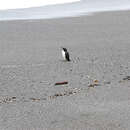Biology
provided by Arkive
Guillemots gather in breeding colonies for the summer. Between May and July, females lay a single egg directly onto cliff ledges; its conical shape prevents it from rolling off (3). At around 3 weeks of age, the young guillemot leaves the colony before it has fledged, and dramatically plunges into the sea accompanied by the adult male (6), who will care for the young at sea until it becomes independent a couple of months later (2), (5). Shortly after leaving the breeding colonies between June and August, adult guillemots undergo the main annual moult, and become flightless for around 6 to 7 weeks (5).
During the winter guillemots disperse fairly widely, with young birds covering the greatest distances (5). Throughout the year, the diet consists mainly of various small species of fish, as well as crustaceans, marine worms and molluscs. Sand eels are particularly important during summer (2). Guillemots dive to obtain food (2), 'flying' under water with their wings (6).
Conservation
provided by Arkive
Research into the effects of large-scale fishing on species of auks, particularly into the effects of industrial fishing of sand eels, is required (2). Furthermore, oil pollution and its effects must be minimised (2).
Description
provided by Arkive
The guillemot is the commonest member of the auk family in the British Isles (3). The head as well as the upperparts are dark brown in colour; the underparts are white. In winter a variable part of the head also becomes white (3). A 'bridled' form occurs in which the eye is bordered with white, and a white line extends backwards from the eye towards the neck (3). The bill is thin, uniformly dark and pointed, and the tail is short, so that in flight the legs are clearly visible; these features allow the guillemot to be distinguished from the razorbill (Alca torda), which also has darker upperparts (3). Young guillemots in their first summer are generally similar in appearance to adults, but have a white area on the throat (3). In breeding colonies, this species is particularly vocal, producing a variety of calls including a deep 'mmmmm' (3), which has given rise to an alternative common name for this species, the 'murre' (4).
Habitat
provided by Arkive
Inhabits both coastal and offshore waters, and nests on coastal cliffs and rock stacks (2).
Range
provided by Arkive
Occurs in the Atlantic and Pacific Oceans (1), breeding on the coasts of the north Pacific and north Atlantic (2). In Britain it breeds in internationally significant numbers (2).
Status
provided by Arkive
Receives general protection under the Wildlife and Countryside Act 1981, and listed under Appendix III of the Berne Convention (2). Included in the Birds of Conservation concern Amber list (medium conservation concern) (7).
Threats
provided by Arkive
Historically, guillemots and their eggs were taken for food, and adults were shot for sport, but this largely ceased after the 1930s. Current threats include oil pollution (2). Although not a current problem, food shortage, thought to be caused mainly by over-fishing, is a potential threat (8). All auks are rendered particularly susceptible to oil pollution by their diving habits (2), and in recent years local incidents of mass mortality caused by starvation have occurred in Scotland (2). Food shortage may prove to be the most serious threat to this species in the long-term (2).

